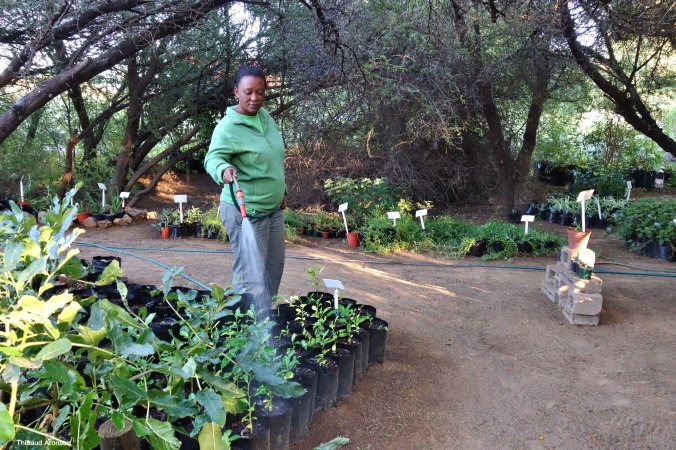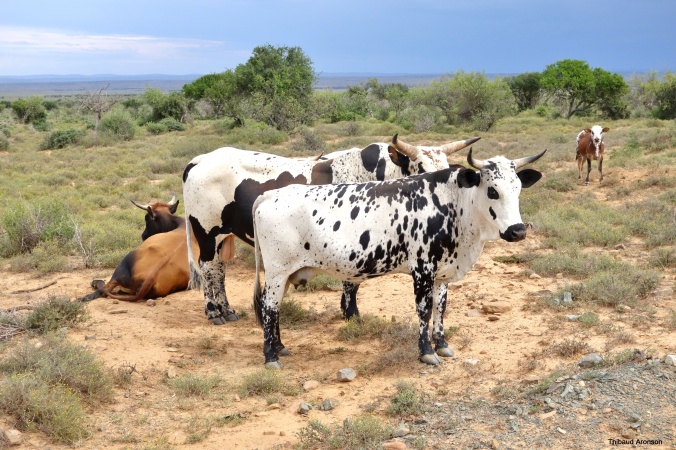In this 4th post from southern Africa, James and Thibaud Aronson report on a pioneering, science-based restoration project, the associated private restoration company, and also a nature reserve, all founded by one pair of scientists in Prince Albert, Western Cape province, South Africa.
Last October, posting from SW Australia, we reported on Gondwana Link and some of the activities of the Australasia chapter of SER. These are just two of the thousands of independent non-governmental groups of people working for joint environmental and social change around the world, as celebrated in Blessed Unrest, Paul Hawken’s 2007 best-selling book dedicated to the “unnamed movement” to reimagine our relationship to the environment and one another. After a year and a half researching our book on arid and semi-arid land trees, and ecological restoration projects and programs in the world’s drylands, we still like our name for that “unnamed movement” Hawken referred to, namely a restoration culture for the 21st century.
Opportunities for grassroots or combined bottom-up – top-down efforts and synergies abound in South Africa, with its outstanding research, technology, and capacity-building from academics, think tanks, not-for-profit organizations, and small companies offering restoration services and counsel. In our last post, we described a few Working for Wetlands programs and the participation of SAN Parks (the body that governs South African national parks) developing new ways to restore natural capital and social capital at the same time. Here we move to the vast central drylands of southern Africa, known very broadly as the Karoo.
As compared to other inland arid regions, landscape complexity here is enormous and, remarkably, ecotones, a.k.a. frontier zones are largely visible, if not intact.

A klipspringer (Oreotragus oreotragus) in the Swartberg, near Prince Albert. This small antelope, which occurs throughout much of sub-Saharan Africa, is unusual in that it walks on the tips of its hooves, an adaptation to its rocky habitat.
This huge inland semi-desert has at least four sub-regions, and borders to the southeast an archipelago of more than 100 recognized types of subtropical thicket, a plant formation forming a key transition zone, in ecological and evolutionary terms, intermediate between forest and savanna. According to plant ecologist Prof. Sue Milton and ornithologist Dr. Richard Dean, the archeological and historical evidence indicate that the Karoo has been largely treeless for millennia. Trees are mostly prevented from growing in the Karoo, not only by the aridity (<200 mm precip./year), but also by shallow soils and cold winter temperatures. The Karoo was prehistorically grazed by nomadic ungulates that were hunted by hunter-gathers (San or Bushmen) and by transhumant pastoralists – the Khoe-khoe. Yet, a huge change came about when European colonization in the 18th century brought wire fencing, deep drilling and wind pumps for extracting underground water. As Sue and Richard put it, “combined with a large demand for wool in Europe, this led to a boom in sheep farming and the development of rural villages, mostly dependent on ground-water.”
We traveled to Prince Albert, a small town in the Karoo, where we met up with our old friends and colleagues Sue Milton and Richard Dean, who are the co-owners of Renu-Karoo Veld Restoration and founders of the Wolwekraal Conservation and Research Organization, a unique research site Sue and Richard acquired in 2007, very near the edge of this isolated town. After nearly 40 years of hard work as international researchers and teachers, Sue and Richard decided to focus their considerable energy for the remainder of their careers to their town, and a community-based restoration and revitalization program for the Karoo. Unlike many NGOs in the “restoration movement” theirs is firmly grounded in science. Prior to launching Renu-Karoo, when they first moved to Price Albert, they continued teaching part-time in Cape Town – a full day’s drive away, and ran the Tierberg Karoo Research Station, a long-term ecological research site nearby, for many years. They have also written or edited the major ecological textbooks on the Karoo, both for basic researchers and managers. And indeed, it is a complex area in need of serious restoration work.
The plant nursery is a key component for all of Renu-Karoo’s activities, producing indigenous Karoo plants and plugs for landscaping and restoration. Availability of indigenous plants in the village has also gradually led to increased popularity of water-wise gardening and to an awareness of local plant diversity.

Sue Milton and Richard Dean surrounded by native and ornamental plants at the Renu-Karoo nursery.

One of the nursery’s 10 employees beginning the day with a round of watering.
As Sue and Richard explain:
“……the vast plains of the Karoo, the wooded drainage lines, the ancient gnarled trees of the dunes and mountains, and the elusive wildlife have been damaged by poor agricultural practices. The area is also currently threatened by development of solar and wind energy generation facilities, and uranium and gas mines that could convert the quiet Karoo into the ‘power factory’ of South Africa. A combination of conservation, education, and continuous active rehabilitation will be needed to enable future generations of people to benefit economically as well as recreationally and scientifically from this rocky and glorious desert landscape.”
When Sue and Richard established Renu-Karoo a decade ago, their goal was to grow and supply Karoo shrub and grass seeds and to provide consulting services on how to re-establish or “repair” Karoo vegetation. Through trial and error, research by students and interns, collaboration with other companies and not-for-profit organizations, and follow-up surveys of restoration and rehabilitation projects, they have produced valuable knowledge, made available both informally and in scientific publications. Additional services, such as contract growing of plugs and plants of never-before propagated veld (the South African name for the sparsely vegetated landscapes typical of the Karoo) plants have added to the interest and capabilities of the business. They also provide free environmental classes and natural history talks and walks to school children and adults. They are truly global citizens working locally to build a Restoration culture in their home, the Karoo.
As part of their work to advance the movement, and raise the bar in restoration and management work, Sue and Richard’s consulting work takes them to businesses and private farms throughout the Karoo. From Prince Albert, we traveled north- east, to visit one such place, the Plains of Camdeboo Nature Reserve, a privately-owned property on the edge of the Karoo.

A male vervet monkey (Chlorocebus pygerythrus) feeding in an Acacia, at Camdeboo National Park.
This nearly 9000-ha property once encompassed three game farms, which were severely overgrazed for a century, if not more. The properties were acquired by Vincent Mai, a South African who lives and works in New York City, and his wife Anne. They wanted to help preserve a piece of the Karoo where Vincent had grown up.
As it was clear that overgrazing in the past had seriously damaged the land, a South African conservation organization, the Wilderness Foundation, was invited to help. For the past six years, this foundation has been carrying out restoration work on the reserve. Their main focus is on eroded and impoverished soils, and they have undertaken a range of approaches, from grazing native Zulu cattle, to using agave stems and hay to block erosion gullies. A number of mammal species were also reintroduced. Angus Tanner, the indefatigable manager, showed us the range of their work on the reserve. Money and manpower is limited, and there are still many obstacles, but they are making great strides. They rely on Renu-Karoo for advice and seeds and technical advice. They are also reaching out to cooperate with the nearby township and their neighbors. Stitch by stitch, and farm by farm, the restoration culture is spreading in the Karoo.

Traditional Zulu cattle in the Plains of Camdeboo Nature Reserve. They both break up compacted soil and fertilize it as the managers move them around the property.

Two adjacent erosion gullies at the Plains of Camdeboo. The one on the right was plugged with a fence gabion and agave stems, in order to slow water flow and trap sediments. The gully on the left was not treated. A year later the difference between the two speaks for itself.










